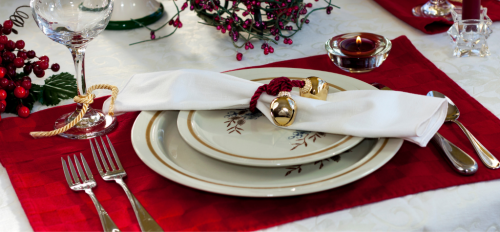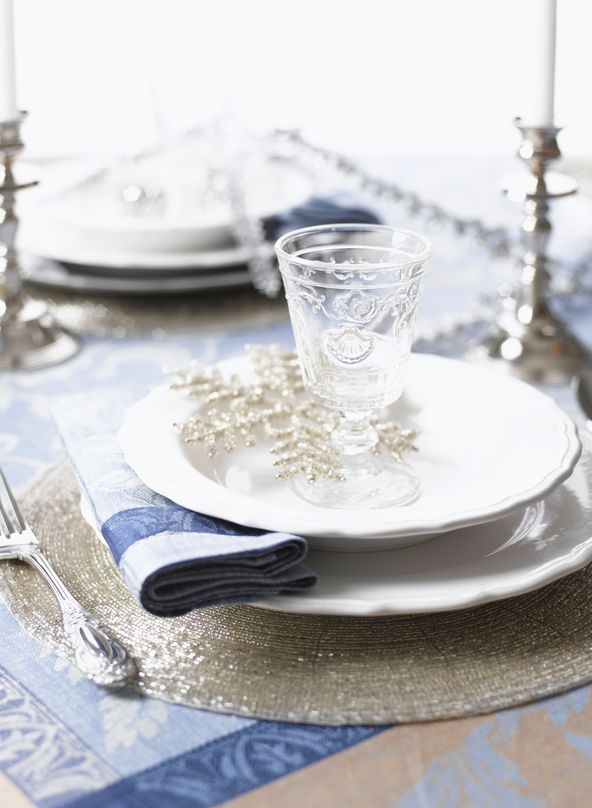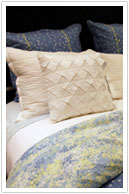Household Items
General Tips
Bedspreads and Comforters
You can typically expect comforters and bedspreads to last five and six years depending on use and care. A bedspread is an outer covering for a bed that goes over the sheets and blankets. It is usually a decorative component of the bed set. A comforter is a quilted bed cover that consists of an outer face fabric, a center batting (usually a fiber mat or down), and a backing fabric. These three layers are held together with a stitched... View Article
Keeping Your Linens Looking Their Holiday Best
Do you want your table to look perfect this holiday season? Many linens are special, as they may have been gifted to you or an heirloom handed down from generation to generation. Unfortunately, even on holidays, accidents happen and you may encounter drink and food spills. Knowing how to properly care for your linens becomes especially important during the holidays. How to care for antique linens: Many families use heirloom linens during the holiday season. Although Anton’s may not... View Article
Ten Tips for Buying and Caring for Bed Coverings
Our August coupon for comforters, bedspreads, blankets and duvet covers is one of the most popular. It is more important than ever to keep your bedding and househould linens clean. The CDC states that garments and bedding must be cleaned at a temperature “above 167° F” in order to kill a virus. Home washers and dryers cannot exceed 135 degrees. At Anton’s, we use high-temperature steam (upwards of 300 degrees) as a standard part of our finishing process – effectively... View Article
Spring Cleaning: Caring for Everyday Household Linens
As many of our customers adjust to life at home and start their annual spring cleaning, we find ourselves answering questions about how to properly care for household linens. As with garments, it is important to have your household items cleaned according to the care label and avoid over-stuffed washing machines. Anton’s Cleaners is committed to helping reduce the spread of disease in our community and safeguarding our customers by sterilizing your garments, bedding and other household items. Our cleaning process naturally... View Article
How to Properly Preserve Your Tablecloth
This time of year, families start to take their holiday décor out of storage. Tablecloths in particular are something that we tend to spend a little extra money on, and want to keep looking perfect throughout the holiday season. It is important to properly preserve your tablecloth to keep it looking as though it is brand new each year. Here are 5 tips on how to care for your tablecloth: Don’t Let Stains Sit Too Long: You can often... View Article
How to Preserve Your Tablecloth
This time of year, families start to take their holiday décor out of storage. Tablecloths in particular are something that we tend to spend a little extra money on, and want to keep looking perfect throughout the holiday season. It is important to properly preserve your tablecloth to keep it looking as though it is brand new each year. Here are 5 tips on how to care for your tablecloth: Don’t Let Stains Sit Too Long: You can often remove... View Article
Properly Preserving Your Tablecloth
With Thanksgiving and the Holiday season upon us, we all want our tablecloths to look perfect. It’s not always an easy task. You can’t just throw them into a washing machine and call it a day. Typically these tablecloths used for special occasions are not cheap and require special care to protecting them for long-lasting use. This includes properly prepping them for storage. Here are 5 tips to properly preserving your tablecloth: Don’t Let Stains Sit Too Long – Avoid... View Article
What’s the Best Way to Clean Bedding?
Bed coverings are a focal point of your bedroom and will benefit from freshening after months of use. Many people only clean their comforters or bedspreads once a season. If you use a duvet cover, you may not have to clean your comforter but once every 2 – 3 years. But if simple shaking does not return your comforter to its original loft, bring it to Anton’s and have it professionally cleaned. Before cleaning, inspect the comforter or bedspread for... View Article
Household Items Questions
“My comforter is soiled and needs to be cleaned. The care instructions say the preferred method is wet cleaning. What does this mean?” A. Wet cleaning is a process used by the few professional drycleaners who have the state-of-the-art computer-controlled equipment that monitors water level, temperature, agitation and soap dispensing. It’s environmentally safe as water is the solvent. The controls can be programmed for many variables, including how fast the drum inside the washing machine rotates, the temperature and amount... View Article
Household Items Questions
- “My comforter is soiled and needs to be cleaned. The care instructions say the preferred method is wet cleaning. What does this mean?”
-
A. Wet cleaning is a process used by the few professional drycleaners who have the state-of-the-art computer-controlled equipment that monitors water level, temperature, agitation and soap dispensing. It’s environmentally safe as water is the solvent. The controls can be programmed for many variables, including how fast the drum inside the washing machine rotates, the temperature and amount of water used, the amount of detergent added to the wash cycle and the air temperature and length of the drying cycle. This makes it a versatile process for many types of fabrics.
- “I understand dust mites can occur even in clean homes. What can I do?”
-
A. House dust allergies are common even in clean homes. The bacteria by-products in dust mites are called endotoxins and adults living in homes with high endotoxin levels are more likely to have asthma and related health issues. Here are a few dust mite-busting tips from The American College of Allergy, Asthma & Immunology to help you keep your family healthier:
- Wash all bedding (including pillows without the cases) in hot water every week to 10 days. (Or let us wash them for you, it would be our pleasure!)
- Regular dry cleaning of comforters and blankets will also eliminate the endotoxins found in dust mites.
- Clean sheets and pillowcases in the same temperatures normally used by commercial cleaners and launderers (very hot — over 130°F) — and dry them in a hot dryer, or have your bedding commercially laundered and pressed. Dust mites cannot live in environments over 130°F.
- Don’t dry sheets outside, since that brings more allergens inside.
- Cover mattresses, box springs, and pillows with allergen-proof casings, which can be purchased at any linen store.
- Think twice before running a humidifier, since humidity encourages the reproduction of dust mites. If you must use one, clean it regularly to prevent mold growth.
- “I had my down comforter cleaned and it is lumpy. It also began to come apart. What can I do to prevent such damage?”
-
A. Although cleaning down items is usually not a problem, a comforter with poor construction and insufficient quilting can cause the down to shift, lose shape, or become matted. It’s a good idea to look for these things before purchasing a comforter. It is also important to check the strength of the stitching. Weak stitching can allow the down to shift and the comforter to come apart.
- “My mother just gave me a handmade quilt that my great-grandmother had made. Is it safe to have it dry cleaned?”
-
A. Handmade quilts need to be treated with great care. If the fabrics were not prewashed before the quilt was made, all colors should be checked for colorfastness. Gently rub a wet cloth over a small area in each section of the quilt. You will see if any of color comes off. Since quilts are made up of many pieces of cloth, it is necessary to test all sections. Some dyes will run in water and mild detergent, while others will run in dry cleaning solvents. If you decide washing is safe for all colors and fabrics in the quilt, fill a tub with water and mild detergent. Gently work the detergent and water into the quilt. Drain the water and fill with fresh water rinsing thoroughly until the water is clear.
If there is any question about the condition of the fabric and its ability to be cleaned, don’t take a chance. Hang the quilt out to air dry instead.
- “I’m getting ready to have our bedspreads cleaned. Is there anything special I need to know before I take them to the cleaner?”
-
A. The answer is “Yes.” Consumers are sometimes surprised when they get a bedspread back from the cleaner to find that the colors have faded and don’t match the companion pieces. Sometimes there’s an overall lightening or a complete change of color. There can also be streaks or a frosted appearance. This occurs because the fabrics are not “colorfast” to dry cleaning solvent. Before doing anything, read the care label. If you have colorfast concerns, ask your drycleaner to test the fabric before proceeding. This is the standard practice at Anton’s Cleaners.
- “What’s the best way to clean an electric blanket?”
-
A. As you might expect, we recommend that you read the manufacturer’s care instructions carefully before doing anything. There may also be a permanent label attached to the blanket.
Unless otherwise indicated, electric blankets should be machine washed on a gentle cycle and line dried. Do not put your electric blanket in the dryer. When hung to dry, electric blankets will not require ironing.
Dry cleaning is not an option. Electric blankets are made with electrical wires that are covered with plastic casing that may be solvent-soluble and expose the wires. This can cause a short circuit or even a fire.
- What do you recommend about pillows, blankets, duvets, and comforters?
-
A. As with clothing, read and follow the care instructions carefully. If labels are on the packaging or are removed because they are scratchy, it is best to keep them in your linen closet or laundry area, so you can find them when needed. Although a drycleaner’s past experience and knowledge of fibers, fabrics and dyes can guide the best and safest method of dry cleaning, saving the labels is the best damage prevention method.
Pillows
If your pillows are synthetic filled, you can wash and dry them. The thickness and density of pillows means that you will need extra rinse and dry cycles. If you have natural filled pillows, like down or feathers, they should be sent to the drycleaner where the ticking is removed and the feathers sanitized.
Pillows are best protected from dust and dirt with a pillow protector and pillowcase. When proper care is taken, I recommend cleaning pillows at least once a year. Freshening up your pillows by airing them out on a dry, sunny day is also a good idea.
Blankets
Blankets should be cleaned before storing away for the spring. Soiled blankets placed in storage attract insects and stains can set and weaken fabrics.
Cotton and synthetic blankets generally can be washed and dried. A fabric softener may be used to help reduce static cling and keep the blanket soft.
For wool blankets, I recommend dry cleaning. If washed, wool blankets can experience shrinkage and lose their shape and softness. Sometimes customers will bring in a blanket that has shrunk and ask us to “stretch” it. Unfortunately, if the shrinkage that occurs is severe it is not reversible. Dry cleaning best maintains blanket size, shape, feel and appearance.
Comforters/ Bedspreads/Duvet covers
While this is a personal decision, most people clean their comforters or bedspreads once a season, or more depending upon use. If you use a duvet cover, you may not have to clean your comforter but once every 2 – 3 years. If simple shaking does not return your comforter to its original loft, it should be cleaned.
Some problems that can occur when cleaning comforters or bedspreads are shrinkage, color loss, dullness, and tears. You can avoid some of these issues at the time of purchase by checking to be sure that the bedspread has been preshrunk and that down or fiber-filled bedspreads are well quilted. Quilting stitches should run both vertically and horizontally with quilting lines 8 to 10 inches apart. Stitching should be strong, as loose stitching can allow the filling to shift during cleaning.
Before cleaning, inspect the comforter or bedspread for rips, tears and weak areas. These articles become quite heavy when immersed in solvent or water and during cleaning these weak areas can enlarge.
It is recommended that you clean or launder all matching and coordinated items (shams, dust ruffles, curtains) at the same time. This helps to ensure that any color or sheen loss is uniform.Storage
Finding appropriate space to store bulky comforters, bedspreads or blankets can be difficult. Items need to be properly cleaned before storing in a dry, well-ventilated area that does not have direct exposure to sunlight or artificial light. Consider trying our Anton’s Closet where storage is in a temperature-controlled facility. You pay only for the cleaning and your household items are safely stored for the season. Click here for more information.
- “We had a great time camping this summer and now it is time for me to clean the sleeping bags. The care label clearly says ‘do not dry clean’, but the bags are too bulky for my washer. What should I do?”
-
A. The dry cleaner can launder your bags, rather than dry cleaning them or you can take them to a laundromat and use a large front-loading washer. It takes time to properly clean sleeping bags. They should be washed on the gentle cycle in cool water, may require multiple rinsings to remove all the soap and should be dried on a low heat setting. Nylon sleeping bag shells will melt if exposed to high heat and down can become lumpy.
Solvents used in dry cleaning can strip the natural oils from the feathers in down bags and cause them to lose their loft and warmth; therefore a quality dry cleaner will launder your bags. Before washing, check the bag for heavy stains, rips or tears. Pretreat any stains and repair damages before cleaning.
When storing your sleeping bags, never use a plastic bag as it can cause mold, mildew and bacterial growth.








